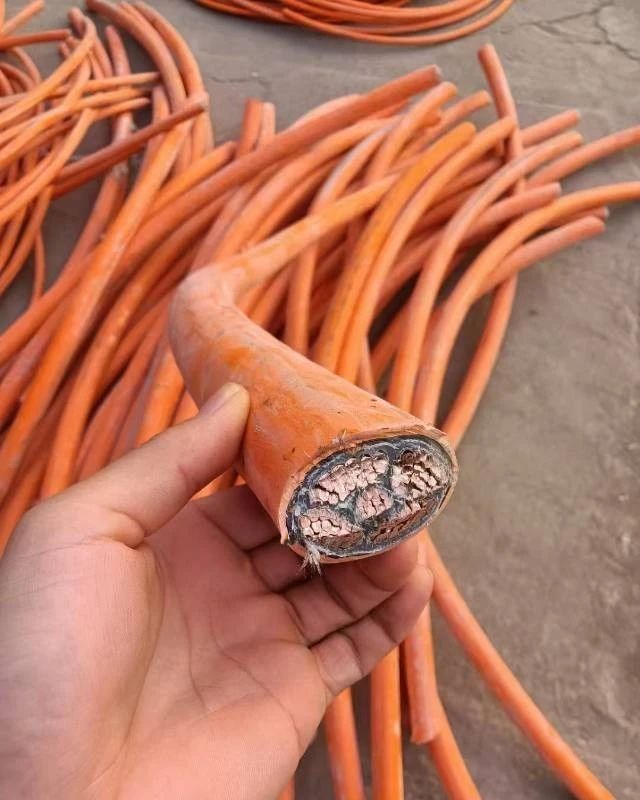
Full Analysis of Waste Cables | Materials, Classification, and Environmental Recycling, Read in One Text!
Release time:2025-10-10
Complete Guide to Waste Cables | Materials, Classification, and Eco-Friendly Recycling – Understand It All in One Article!
I. Cable "Anatomy": Materials and Structure
Cables act as the "blood vessels" for power transmission, and their internal structure directly affects their performance and recycling value. Below are the core components of common cables:
1. Conductor (Core Layer)
Low-Voltage Cables: PVC (Polyvinyl Chloride), PE (Polyethylene)
High-Voltage Cables: XLPE (Cross-linked Polyethylene), Rubber
High-voltage insulation is thicker and has stronger high-temperature resistance.
Function: Isolates the conductor from the external environment, preventing leakage or short circuits.
3. Screen/Shielding Layer (Specific to High-Voltage Cables)
Function: Equalizes electric field distribution and reduces electromagnetic interference.
Structure: Copper tape/copper wire braid + semiconducting material.
4. Sheath (Outer Protective Layer)
Material: PVC, polyurethane, or armored metal (for mechanical damage protection).
Identification: Surface is printed with information like voltage rating, model, manufacturer, etc.
二、 High-Voltage VS Low-Voltage Cables: Four Core Differences
Comparison Item
Low-Voltage Cables (≤1kV)
High-Voltage Cables (≥10kV)
Application Scenario
Home circuits, small equipment power supply
Power main grids, industrial power transmission
Structural Complexity| Simple (Conductor + Insulation + Sheath)
Multi-layer (Screen, Water-blocking layers, etc.)
Insulation Requirements | Standard voltage resistance (PVC/PE)
High voltage resistance, high temp resistance (XLPE)
Recycling Value
High copper yield, easy sorting
Contains multiple metal screens, requires professional disassembly
Key Tip: Due to their complex structure, high-voltage cables require professional equipment to separate the copper conductor from the shielding layers. Disassembly by individuals can easily lead to resource waste and safety risks. Low-voltage cables are common in construction waste, have relatively high copper purity, and offer better recycling economics.
Scientific Recycling Process
1. Sorting & Classification: Categorized by voltage level and conductor material (copper/aluminum).
2. Mechanical Stripping: Using cable strippers, crushers, etc., to separate metal from insulation.
3. Environmental Treatment: Safe disposal of halogen-containing sheaths (avoid incineration pollution).
Disclaimer: This article is for knowledge sharing only. The content is original and does not constitute investment or trading advice.
Note: This article is sourced from the "Longqian Cable Recycling" WeChat public account.
I. Cable "Anatomy": Materials and Structure
Cables act as the "blood vessels" for power transmission, and their internal structure directly affects their performance and recycling value. Below are the core components of common cables:
1. Conductor (Core Layer)
Material: Typically copper (high conductivity, corrosion resistance) or aluminum (lower cost, lightweight). Copper conductors are common in high-voltage cables or precision equipment.

Form: Solid or stranded; cross-sectional shapes include round, sector-shaped, etc., which affect current-carrying capacity and heat dissipation.

Low-Voltage Cables: PVC (Polyvinyl Chloride), PE (Polyethylene)
High-Voltage Cables: XLPE (Cross-linked Polyethylene), Rubber
High-voltage insulation is thicker and has stronger high-temperature resistance.
Function: Isolates the conductor from the external environment, preventing leakage or short circuits.
3. Screen/Shielding Layer (Specific to High-Voltage Cables)
Function: Equalizes electric field distribution and reduces electromagnetic interference.
Structure: Copper tape/copper wire braid + semiconducting material.
4. Sheath (Outer Protective Layer)
Material: PVC, polyurethane, or armored metal (for mechanical damage protection).
Identification: Surface is printed with information like voltage rating, model, manufacturer, etc.
二、 High-Voltage VS Low-Voltage Cables: Four Core Differences
Comparison Item
Low-Voltage Cables (≤1kV)
High-Voltage Cables (≥10kV)
Application Scenario
Home circuits, small equipment power supply
Power main grids, industrial power transmission
Structural Complexity| Simple (Conductor + Insulation + Sheath)
Multi-layer (Screen, Water-blocking layers, etc.)
Insulation Requirements | Standard voltage resistance (PVC/PE)
High voltage resistance, high temp resistance (XLPE)
Recycling Value
High copper yield, easy sorting
Contains multiple metal screens, requires professional disassembly
Key Tip: Due to their complex structure, high-voltage cables require professional equipment to separate the copper conductor from the shielding layers. Disassembly by individuals can easily lead to resource waste and safety risks. Low-voltage cables are common in construction waste, have relatively high copper purity, and offer better recycling economics.
Scientific Recycling Process
1. Sorting & Classification: Categorized by voltage level and conductor material (copper/aluminum).
2. Mechanical Stripping: Using cable strippers, crushers, etc., to separate metal from insulation.
3. Environmental Treatment: Safe disposal of halogen-containing sheaths (avoid incineration pollution).
Disclaimer: This article is for knowledge sharing only. The content is original and does not constitute investment or trading advice.
Note: This article is sourced from the "Longqian Cable Recycling" WeChat public account.

